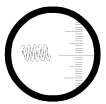< Page 4 of 9>
1 2 3 4 5 6 7 8 9
Radiuscope

The radiuscope is designed to accurately measure the radius of curvature of the anterior and posterior surfaces of rigid contact lenses. All the commonly
available radiuscopes operate using procedures similar to the following:
- A drop of water
is placed on the lens mount upon which a contact lens is floated convex
side down.
-
A spot of light is centered in the middle of the lens and the body of the microscope is raised as high as it will go.
-
The microscope is then focused downward until a spoke pattern, the first of three images, comes clearly into view. This is called the aerial image and represents the reflection from the posterior surface of the lens. Once the aerial image becomes sharply focused a pointer is set to zero on the scale.
- Continue to move
the body of the microscope downward. On the way to its final location,
an image of the bulb filament will come into view. Continue beyond this
image.


 Aerial ImageBulb FilamentSpoke Pattern
Aerial ImageBulb FilamentSpoke Pattern
- Eventually, another
spoke pattern will come into focus. This represents the level of the
lens surface, so it is possible to observe surface details at this point.
Focus this third image as sharply as possible. The reading on the scale
now represents the radius of curvature of the lens surface in millimeters.
-
It is generally advisable to double check the final reading. This can be accomplished by focusing the microscope all the way up to the original aerial image. At this point the pointer should once again be on zero. If not, reset it at zero and repeat the entire process.
Toric Curves: Toric curves are somewhat more complex to interpret than spherical curves, although the technique employed is the same. Since a toric surface contains two separate radii of curvature not all the spokes in the pattern will be in focus simultaneously. Taking an accurate reading, therefore is a matter of making two separate measurements for each lens surface.
A parallel may be drawn here to the use of a lensometer for the purpose of neutralizing a spectacle lens. While spherical lenses contain only one power, those containing cylinder require the reading of two powers.
 |
 |
 |
|
When a toric contact lens is rotated in a clockwise motion different spokes on the target will come into focus as illustrated in the figures above. |
||
< Page 4 of 9>
1 2 3 4 5 6 7 8 9